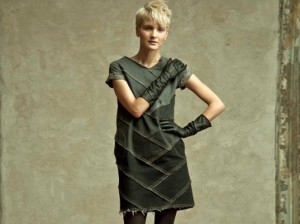The Challenges of Eco-fashion Using Pre Production Wastes
6 min read
The Green Guide | Green Living Tips, Product Reviews, Buying Guides, Environmental Health News and Online Stores –
 Before you start tossing those unused and old clothing into the trash can, remember that there are a lot of people who might not have proper clothing attire every day. While the cliché one man’s trash is another man’s treasure is quite old, it still always emanates truth, especially in up cycling. Popular designers in the likes of Chanel, Balenciaga, and Louis Vuitton have long been known for their trendy masterpieces, but designers like Stella McCartney, From Somewhere, and many others are well-admired for their creative collections as well as their commitment to saving the Earth from destruction contributed by the fashion industry. The latter isn’t just a group of designers; they’re a group of artists who are very much dedicated to finding value in items that some people devalue.
Before you start tossing those unused and old clothing into the trash can, remember that there are a lot of people who might not have proper clothing attire every day. While the cliché one man’s trash is another man’s treasure is quite old, it still always emanates truth, especially in up cycling. Popular designers in the likes of Chanel, Balenciaga, and Louis Vuitton have long been known for their trendy masterpieces, but designers like Stella McCartney, From Somewhere, and many others are well-admired for their creative collections as well as their commitment to saving the Earth from destruction contributed by the fashion industry. The latter isn’t just a group of designers; they’re a group of artists who are very much dedicated to finding value in items that some people devalue.
These creative designers deal greatly with pre and post production. When we say pre production, it means the extra fabrics, damaged dyed sheets, materials used in print testing, burned fleeces, unpicked cotton, poor fibers, damaged finished clothing, and the likes. These are commonly dumped into landfills, creating huge piles of wastes. Meanwhile, post production wastes are materials used after the creation of apparels as well as old and unused clothing. What these groups of artists do is that they discard at least 15{533314f2540bdd33bbc04377fd32ff805adcd56cc20929d47e9b088aa1bb02ce} of wastes during textile production, and this particular activity is dubbed as upcycling. Meanwhile, recycling is the re-use of unused materials, providing purpose to it while downcycling is the term used to refer to an activity that makes use of materials in less valuable purposes. An example of recycling is a big shirt turned into a whole dress or skirt. An example of downcycling is turning unused cotton as stuffing for toys, car seats, and couches. However, turning unneeded fabrics into something of use like fashionable garments is called upcycling since value is placed on garbage.
Fortunately, designers like McCartney don’t see these pieces valueless. While McCartney is renowned for her incredible collections using post production waste materials, Orsola de Castro, the head of From Somewhere, is a topnotch in turning pre production wastes into works of art. In fact, the brand is one of the most celebrated names in the world of artistic upcycling. Orsola de Castro has been vocal about the wastes that the fashion industry has imprinted on our environment, citing the fact that too much is discarded and thrown away that is yet intact and still beautiful. In order for de Castro to come up with beautiful collections and realize her designs, she works with some of the most skilled manufacturers in Italy. In their rooms, she imagines, cuts, chooses, scrutinizes, and patches discarded pieces together to come up with fun, chic, and modish separates. The pieces are then put together, creating youthful and perky collections that are undeniably the highlight and distinguishable features of From Somewhere garments. Garments from From Somewhere are neither fancy nor dull as each of them bursts into poetic life from rubbish, a feature that other brands don’t have.
But you should never think that working with pre production wastes is easy. It is never a breezy process as designers have to face the challenges that come across with rubbish like inconsistency in the size, color, texture, and weight of the materials. Eco-designers must learn to cope with the diversity of these materials and turn them into something beautiful. In fact, the sourcing process is deemed to be the most time consuming part of up cycling as every swatch and fabric is meticulously scrutinized and thought about, so these could be made into fashionable garments. Aside from time constraint, scaling production is also costly in terms of labor costs even if the raw materials used are cheap or free. Orsola de Castro can even think of the times when they still have to convince manufacturers to give them their wastes. These days, these manufacturers already have their own system for From Somewhere as they set aside their pre production wastes in bags, ready for de Castro and her men to pick up. Furthermore, more and more manufacturers are getting in touch with her to address their own waste management issue. From Somewhere’s popularity has enable it to partner with other apparel manufacturers like Speedo. Speedo donates unused materials that are considered ‘dead stock’ by the company mainly from its banned LZR racer suit. Basically, Speedo does not only donate the banned items as they also donate garments that are dyed undesirably, left over garments, and cancelled ordered pieces. Prior to the existence of From Somewhere, these pieces are either incinerated or sold to middlemen or emerging and newbie designers at very cheap price just to get cash from it and have some space for storage. The relationship of Speedo and From Somewhere eliminates the middleman and moves on with pre production waste management without an intermediary that may not be able to utilize all of these wastes fully.
Since dealing with pre production waste is somehow time consuming, some designers like R.ds have found ways to eliminate this lengthy procedure. They cut the fabric into standard sizes and narrow down the type of fabrics sourced to cut down the time. R.ds is a fashion label that partners with some of the leading manufacturers of Italian men’s wear that create simple garments even without the expertise of a designer. Meanwhile, major brands have all the opportunity to create more interesting pieces on their wastes.
The good thing in this niche is that Orsola de Castro isn’t alone in her feat as Australian brand Steinwidder has other ideas of up cycling in terms of the producing unique and chic women’s underwear pieces. The label has been working with factory socks that have been damaged during pre production, which are imaginatively turned into avant-garde and urban swimwear collections without concealing the diversity of the main materials used. To achieve such look, Steinwidder interconnect the collected socks to come up with a smooth design to come up with stylish, individual pieces. Certainly, sky is the limit for this company when it comes to creating edgy swimwear using socks.
Just recently, From Somewhere has made collaborations with Tesco in producing garments for its F&F Line, which basically showcases designs from its left over jersey textiles from the previous year. Apart from that, Orsola de Castro is also designing for Top Shop, another renowned label in the fashion industry. Top Shop has tapped her to turn unfinished stocks, left over garments, and obsolete fabrics into something beautiful and appealing. Her collections from the two giants have been received well in the public, specifically by notable personalities. Meanwhile, it is de Castro’s dream to entice big time garment creators to repurpose their own wastes. Imagine the wastes being cut down when these fashion giants put value to their unused fabrics, eliminate the hype on ‘limited edition’ designer collections, and focus more on the challenges of stopping their rubbish from becoming a threat to our environment. Orsola is not naïve to the fact that upcycling isn’t a breezy feat. It is highly feasible, but not a lot of designers and garment industries are keen to the idea of upcycling. Some designers think that this method isn’t for them, but it is entirely different for de Castro because she’s looked at fashion the way these designers could not possibly revel.
(c) The Green Guide | Green Living Tips, Product Reviews, Buying Guides, Environmental Health News and Online Stores – Read entire story here.





